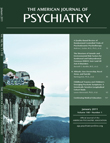Abuse in Childhood and the Risk for Psychotic Symptoms in Later Life
It is now well appreciated that many mental disorders do not emerge de novo in adulthood. Rather, substantial pathophysiological components and even some symptoms often appear much earlier in life. Prevention efforts in the pre-illness period of childhood focus on environmental issues, including the family environment and particularly child care and parenting. Such efforts have followed results of a broad range of epidemiological studies that identified potential risk factors for the later eruption of symptoms.
A recent series of such studies has focused on psychotic symptoms measured in late childhood and early adolescence. The article by Arseneault et al. in this issue (1) reports on a study of a large twin sample from the general population that has previously been used for such research. The study investigated the shared impact of two strong risk factors for psychotic symptoms identified at age 12 in some children—abuse by adults and bullying by peers in preschool and school-age children. The authors view these risks as two versions of trauma resulting from an “intention to harm” directed toward the child. Both of these risks have been identified as related to or predictive of other mental disorders, including antisocial personality disorder. Here the authors show that the association with psychotic symptoms is independent of genetic vulnerability (as indicated by maternal psychosis or estimated twin symptom risk level), symptoms of internalizing or externalizing disorders, and IQ, as well as socioeconomic deprivation status, which itself is associated with both “intention to harm” risks. The authors suggest that a child's reaction to experiences of “intention to harm” may include psychotic symptoms. The authors' thorough examination of the combined effects of different environmental traumas also attributed a marginally significant increase in risk to a history of serious accidental injury. Some such “accidents” may have reflected parental negligence or worse. Despite the authors' meticulous evaluation of the child-reported symptoms, they could not assess whether the children's psychotic symptoms represented a reaction to potential threats or self-protective strategies against these threats. A similar study (2) also showed a dose-response relationship between the level of psychotic symptoms and the severity of bullying victimization in children. Together, these new studies provide evidence of the distressing, long-lasting effects of early adverse experiences in children at the hands of their peers and caretakers.
There are many reports of the association of childhood bullying victimization with depression and suicidality. This impact of early bullying can also persist into adulthood (3). Exposure to school bullying predicts poorer adult health-related quality of life, including poorer mental and physical health (4). Nevertheless, despite increasing efforts in most developed countries, programs designed to prevent or stop bullying have been far from effective. The literature focuses particularly on bullying among junior high school students, which is fairly prevalent and difficult to prevent or control. In the Arseneault et al. study, we see that bullying begins in or before elementary school and has long-term serious negative effects. Teachers' efforts to prevent these behaviors are apparently not very successful. Interventions for bullied elementary school children may be effective, but primarily when they involve extended individual attention (5).
Unfortunately, new avenues for bullying have emerged. Cyberbullying is now affecting even fairly young children and is increasing annually, as reported in a study of 11- to 13-year-olds in England (6), and it is associated with adolescent suicide (7).
1. : Childhood trauma and children's emerging psychotic symptoms: a genetically sensitive longitudinal cohort study. Am J Psychiatry 2011; 168:65–72Link, Google Scholar
2. : Prospective study of peer victimization in childhood and psychotic symptoms in a nonclinical population at age 12 years. Arch Gen Psychiatry 2009; 66:527–536Crossref, Medline, Google Scholar
3. : The association of suicide and bullying in childhood to young adulthood: a review of cross-sectional and longitudinal research findings. Can J Psychiatry 2010; 55:282–288Crossref, Medline, Google Scholar
4. : Does school bullying affect adult health? population survey of health-related quality of life and past victimization. Aust NZ J Psychiatry 2009; 43:1163–1170Crossref, Medline, Google Scholar
5. : School-based mentoring as selective prevention for bullied children a preliminary test. J Prim Prev 2010; 31:171–187Crossref, Medline, Google Scholar
6. : “I h8 u”: findings from a five-year study of text and email bullying. Br Educ Res J 2010; 36:643–671Crossref, Google Scholar
7. : Bullying in middle schools: results from a four-school survey. J Sch Violence 2009; 8:264–279Crossref, Google Scholar



